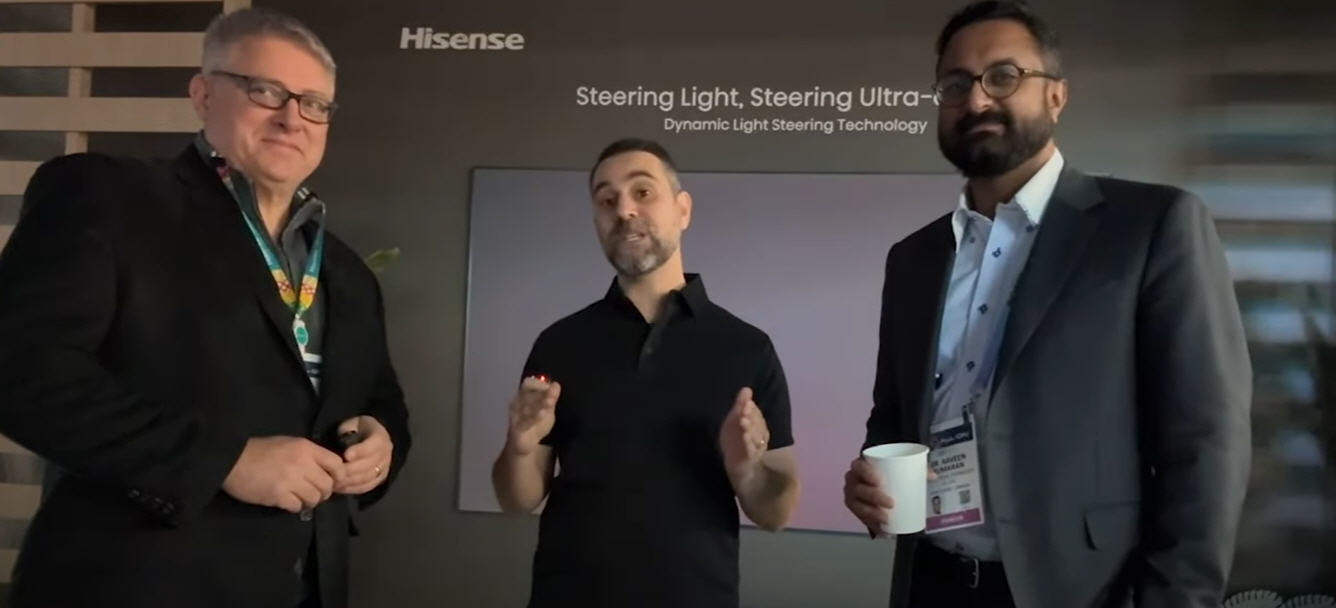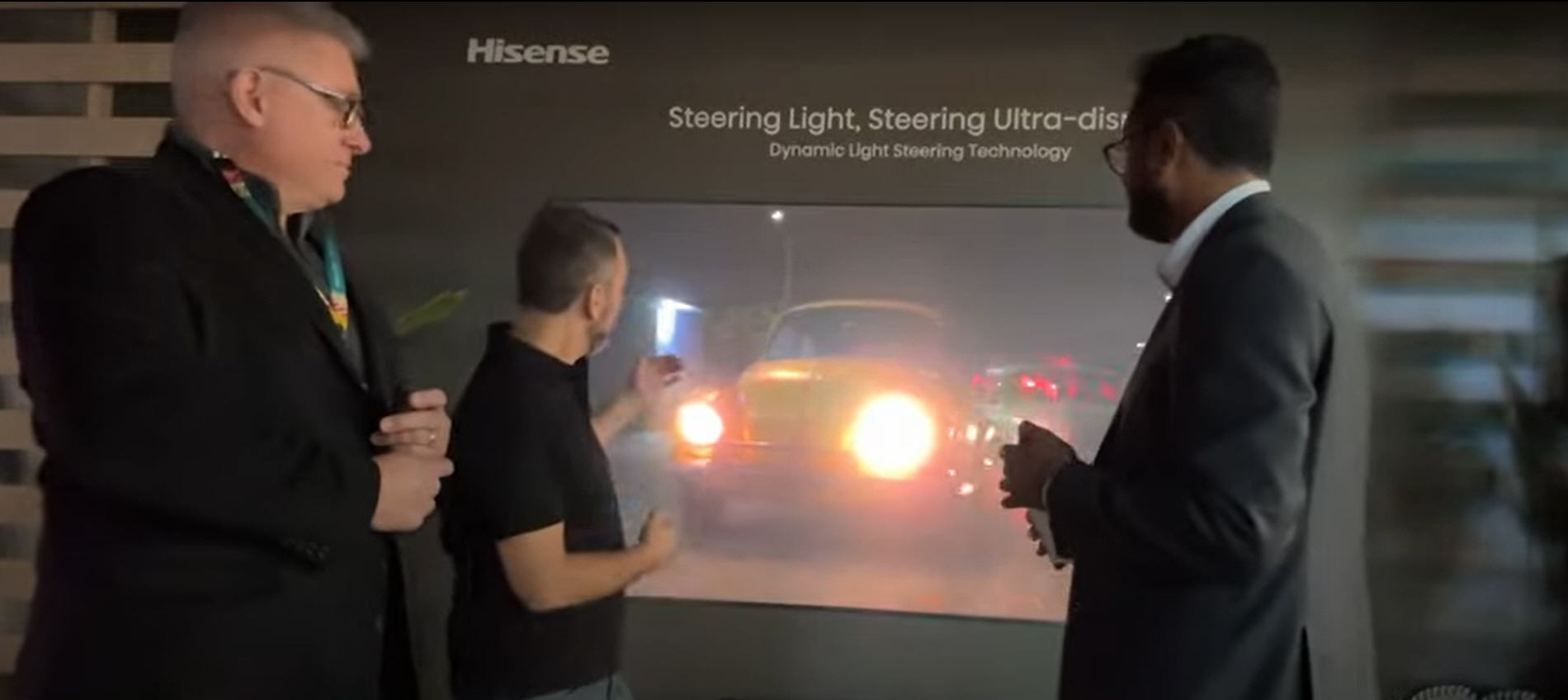What's up everybody? It's Brian with projector screen.com and I am here at the Hisense booth at CES 2024.
The thing that I'm most excited about and what I find to be the most innovative and interesting piece of projection technology at the entire expo is right here. What we've got is a new technology developed by Barco in conjunction with Hisense, which is referred to as Light Steering. Now to boil this down to its most simplistic terms, it's really almost like local dimming for projection. It's pretty friggin’ crazy.
So as opposed to me fumbling through with the technology, I'm gonna really leave it up to the experts right here to get more in-depth and detail how exactly this works. And then we can get into what the benefits of this technology mean for projection and how it's gonna give you an experience unlike anything that we've seen before with reflective projection technology.

Brian: Alright, so I'm gonna kick it off here first. My buddy Rob, who I've been working with for many years at Hisense, and also Raveen from Barco, who I just met today, but we've already become best friends. Okay? So, would either of you like to begin this thing?
Rob: I'm gonna defer to Raveen to start.
Brian: All right, so Raveen, please let the viewers kind of get an overview of what we're looking at here, and then obviously we're gonna take a look and demonstrate some of the key points that this, light steering technology is producing here on this daylight screen from Hisense with this projector that's built on a Hisense chassis with special secret sauce put in there by Barco.
Raveen: What I'm gonna talk about is the special version of light steering that Barco has developed for the consumer space called Barco Bright. So our product in the future is gonna be something like a “Hisense Laser TV with Barco Bright”. And what are we doing? Really, we're solving all of the big problems of projection, well, not all of the big problems, but let's say the main problem
Brian: So, we're addressing one of the biggest criticisms of projection versus a missive display technology. And it really comes down to contrast. This addresses it in a revolutionary new way. Sorry for stepping in.
Raveen: No worries. The idea is that most projectors have limited brightness, limited contrast because there are inherent limitations to the components in the systems compared to a flat panel display. What we do here with the Barco Bright technology is we use commodity components, but we do something smart called light steering that basically reallocates light based on content. So imagine when you're watching a movie and there's shadows and highlights, normally the shadows are too elevated, the highlights are too dim. But what we can do is that in real time we can reallocate or steer the light away from the shadows where it's not needed and concentrate or focus it into the highlights. What this means is that the highlights get much brighter, the shadows get much darker giving an overall higher contrast image, but more importantly we can do it without an additional light source. So it's still very “green”, it's very efficient, but because of the ability of just remapping or steering light in real time, we can achieve this higher dynamic range content. So gone are the days when you play a Blu-ray or your Netflix or streaming content at home on your projector and you're like, oh, my highlights are clipped, or the shadows are too murky, I can't see any of the detail. We address that with the Barco Bright system.

Brian: Sure, and we're gonna get some better footage of it later, but I'm seeing it in the projection of what's going on behind us. The headlights are a perfect example of what this technology is. What we're seeing with this technology as opposed to casting light uniformly around the screen, we're sucking the light energy out of where light is not needed and bringing it into where it is needed, such as the headlights right over there. So I'm gonna ask Rob to kind of explain to us what that means from an efficiency standpoint and what that means with having “x” lumens in a projector producing an image using this technology versus uniformly diffusing the light over the entire screen.
Rob: You bet! So, when you get right down to it as a projector manufacturer, we're always trying to chase that elusive contrast ratio trying to improve upon the black level. 'cause let's be honest, color fidelity resides between the deepest of blacks and the brightest of whites, and Barco Bright technology addresses that. So we're chasing better contrast, you know, keep in mind the projectors as a single point light source, if they're rated at 2200 lumen, we're showing 2200 lumen typically across the whole thing, the bright parts as well as the dark parts. So what you're finding is that gray or lightning effect of those dark shadows, which is counter to what we really want to accomplish. So with, with Barcos light steering technology, they're able to modulate that light output to the individual portion of the scene real time before it hits the DMD and reduce that power on the shadows details and, and again, brightening it up by like 500% on the bright parts.
So it is my understanding that some of the demo scenes that they were using for testing would be scenes like the lightsaber duels from Star Wars. It’s the perfect example where there tends to be a lot of darkness as well as the brightly illuminated components of that scene. So for me, as we talk about larger screens, and larger applications, you're ultimately seeking that immersive experience and what better way to keep you in the experience than with fidelity of color and a high contrast ratio. I mean, that's the thing we're really chasing, right?
Brian: Well, absolutely. And you know, kind of what we're talking about here is oftentimes consumers are making a decision, right? Do we want to go with like an OLED technology where we can turn off pixels and get the best contrast in black levels possible at the sacrifice of having a huge immersive experience, right? What we're solving with this problem right now is that you're gonna have the best of both worlds. You're gonna be able to get 150 inch ambient light rejecting screen paired with a laser TV projector and maybe not quite get to the same level of blacks as an OLED, but get something that's substantially more impressive than even the best performing native contrast ultra short throw projectors that are out right now. So what I'm gonna ask all of you to do is put a big pressure campaign on both Raveen from Barco and Rob from Hisense, sorry for throwing you under the bus.
Rob: Well it's, it's gonna take time.
Raveen: We welcome the pressure.
Brian: And with that pressure campaign, we're gonna get them to try and lend me this projector at some point so that I can throw up a checkerboard pattern and start to get really into the weeds about the measurements and what we're really seeing from the light steering technology. Now, I can't get them to commit, but I figure the pressure campaign may be helpful.
Raveen: We're based in Vancouver, so you're always welcome to come on up and we can do some testing there.
Brian: Hey, I'm gonna take you up on that! So Ravine, thank you so much. It's been a real pleasure. I'm super excited about this and I definitely am gonna take you up on that invitation. And Rob, pleasure as always, we'll be talking again about the next Hisense product as we mosey on over there, but this is a separate clip just for the people that have shown insane amounts of interest in this technology, myself included. So thank you guys and keep on projecting!
